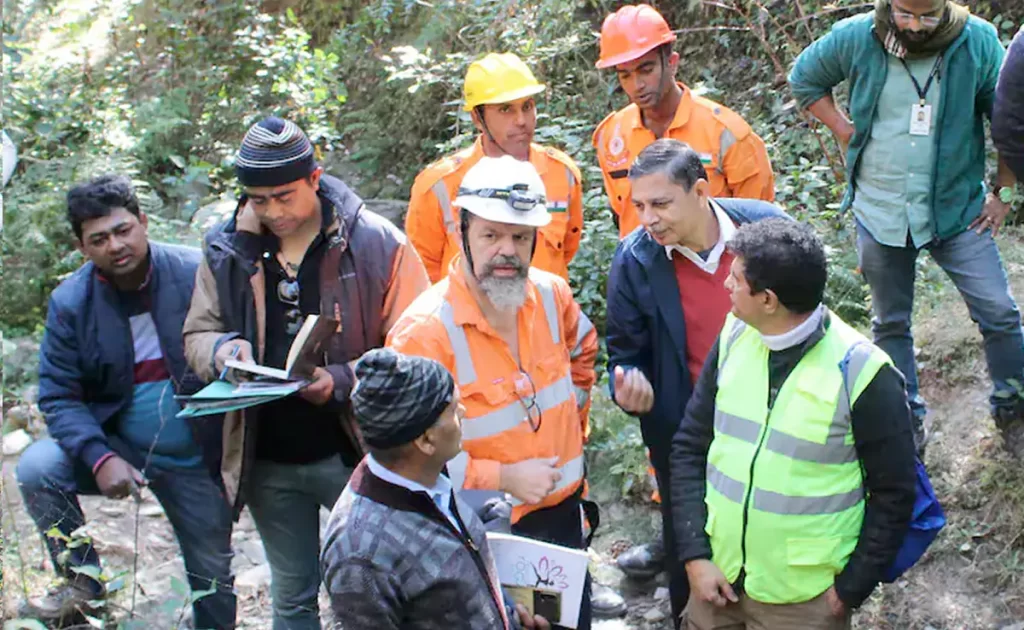New Delhi:
The “softly, softly” approach to drilling escape holes, and gauging the auger’s impact on the already fragile and “still moving” mountainside, were key to freeing the 41 men trapped beneath the collapsed Silkyara tunnel in Uttarakhand, tunnelling expert Arnold Dix told NDTV Wednesday, hours after a precise 17-day rescue operation came to a successful conclusion.
Arnold Dix, a tunnelling expert and a professor of engineering, also told NDTV he was not surprised by ‘rat hole’ miners – practitioners of a mining process banned by the Supreme Court in 2014 for being unsafe and causing environmental pollution – being the key in the Uttarakhand tunnel rescue.
“My view was that we needed to go softly… I was confident nobody would be injured as long as we took our time and were careful. So we had to go ‘softly, softly’ and, in the end, we achieved our mission 100 mm at a time… digging by hand,” Professor Dix explained, “This was important because we didn’t want to disturb the mountain and cause another avalanche or disturbance.”
“I did anticipate ‘rat hole’ mining would be the breakthrough. That was part of the advice I gave because I could see that with every big machine used the mountain’s reaction was more severe.”
In the days that immediately followed the tunnel collapse, rescue teams used large earth drilling machines, or augers. These, however, would prove to be unsafe because the vibrations produced while it was drilling raised fears of a landslide; on one occasion drilling was halted because of a ‘cracking’ sound from the collapsed section, which raised fears a cave-in could bury the workers.
The larger drills also broke down repeatedly after hitting metal obstacles, specifically steel rods from the collapsed tunnel structure. This forced more pauses while laser cutters were deployed.
Concerns such as this, and, of course, the ultimate goal of rescuing all 41 trapped men, led to frequent halts in drilling while experts onsite debated the pros and cons of each action. Professor Dix told NDTV the rescuers considered (till the very end) multiple options to save the men.
“We knew they could all, potentially, work. But what we had to do was balance the benefits and risks of each plan. We were receiving a whole lot of information – from satellites (data from the Japanese via the Italians) and aerial surveys by drones, as well as data from within the tunnel.”
“We could see mountain was still moving and so had to avoid another disaster. Therefore, we had to balance all options against each other as proceeded with the rescue op,” he explained.
The professor cited the example of the debate that preceded building a new road to the top of the collapsed structure to begin vertical drilling. He said experts routinely discussed the need to balance the lives of those trapped inside with risks to the rescuers and those to the environment.
“We thought long and hard because we knew it would have an impact on the environment. We were also worried about ground water levels and didn’t want to damage underground supplies.”
“Yes, we were under criticism for how slowly we went but because our mission was saving lives we were really careful in the order of things we did. We were building multiple (escape) doors yes… but were careful about how each might affect the other,” he said.

41 trapped workers were all safely rescued from the collapsed Silkyara tunnel in Uttarakhand.
“We were always going to bring them home safe. We had several plans… they failed till this one (the ‘rat hole’ miners) but even if this too had failed, we had more. We were not giving up.”
After 17 days of careful planning and cautious drilling, culminating with the efforts of the ‘rat hole’ miners, the first of the 41 trapped labourers was freed, and the professor said he cried tears of joy.
“If you could have seen my face, you’d have seen some tears and I think that says it all. There are no words,” he told NDTV when asked what his initial reaction was when the first man emerged.
“I never lost hope. I always felt we were going to bring them home safe and that nobody would be hurt. Like I said on the first day… I promised they would be home for Christmas.”
“We didn’t know how (the rescue would be effected) but we knew our mission. It was a fantastic team – Indian experts and those from abroad. We worked together to make it happen,” he said.
“In fact, all the men even came out themselves. We didn’t have to bring them out on stretchers. They were like ‘Hi, great to see you. Can we come out?’ and they just walked… well, not really walked… crawled through. In the end, the ‘softly, softly’ was key.”
The professor played down his role in what is being hailed as India’s largest such rescue – involving thousands of emergency personnel and multiple central and state agencies, as well as the Army, the Air Force and other paramilitary forces. “I am not the brains… am just a part… maybe one brain cell.”
“My story is simple. I got a call from the government on Day 1, telling me what had happened. We had a discussion and then, when things didn’t go so well, I received another asking if I could come.”
“I said, ‘Of course’. That is what good people do,” Professor Dix said, after making it a point this morning to offer prayers at a makeshift temple outside the tunnel entrance to say “thank you”.




